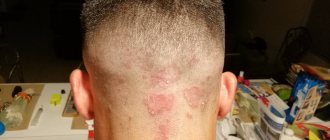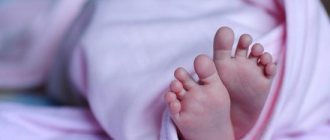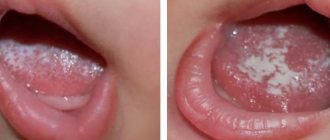Any mother who sees bright red spots on the back of her baby’s head will begin to worry. And this concern is often completely unjustified, because often the cause of such rashes is harmless phenomena. As a rule, 50% of newborn babies can boast of red spots on the back of their heads. In some children they appear scattered, and in other babies they appear as a large scarlet spot. The shade of these spots can also vary from pink to bright red, close to crimson.
Redness on the back of the head of infants
Almost all red spots on the back of the head in newborn babies are birthmarks. They are sometimes accompanied by small hemorrhages on the bridge of the nose. Over time, they disappear on their own and do not require medical intervention. But this is only one of the reasons for skin pigmentation. They may be safe or require supervision by a pediatrician.
Safe
Red spots on the back of the head in newborns often represent:
- Birthmarks;
- Clamps received during childbirth;
- Prickly heat.
Miliaria is small rashes in the form of red spots that appear on some parts of the body. They may swell, itch, and spread over the skin. In addition, prickly heat may disappear in one place and appear in another.
Birth clamps are reddish spots with jagged edges. They are often symmetrical and can be located in the occipital region or in the bridge of the nose. They occur during natural childbirth, when at the stage of the baby passing through the cervix, the contraction stops and the baby stops in the birth canal so that the doctor sees the top of his head.
It is at this moment when the contractions are interrupted and these spots appear. In places where the cervix squeezes the baby, blood vessels burst, which resembles the formation of a hematoma. However, unlike this pathology, the clips do not change color, but remain red until they disappear. When the child cries or worries, the spots become brighter.
Birthmarks, unlike miliaria and birthmarks, do not change their color. They most often grow together with the toddler, but their size changes slowly, imperceptibly to others.
"Important information! If a birthmark changes size, color or shape, the child should be shown to a doctor, as this may be evidence of the development of melanoma.”
Dangerous
Dangerous spots on the back of a baby’s head are:
- Hemangioma;
- Allergies.
Hemangioma is a benign tumor consisting of skin or blood vessels that does not require medical intervention. If it appears in the occipital region, it does not require frequent monitoring by a pediatrician. Most hemangiomas disappear on their own by age 5 or 10.
Only those hemangiomas that are located near the ears, eyes or on mucous membranes pose a threat to the health of the toddler. Such neoplasms should be constantly monitored. If they grow not on the surface of the skin, but inward, touching the organ on which or next to which they are located, they must be removed. But you shouldn’t worry about this, since the specialist will select the most gentle method that will help you completely get rid of the tumor.
An allergic reaction can be either food or contact. Food mainly spreads throughout the body, affecting not only the back of the head. Contact, on the other hand, occurs precisely at the point of contact with the stimulus.
Vascular nevus (“stork bites”)
Most newborns have areas where many blood vessels cluster in bunches and show through thin skin
Most newborns have areas where many blood vessels cluster together and show through the thin skin. These reddish-pink marks, smooth to the touch, are most noticeable on the eyelids, on the back of the head and in the middle of the forehead. These spots are not, to put it correctly, rashes. They are called vascular nevi or, in the language of parents, birthmarks. Grandmothers dubbed them “stork bites.” But no mythical stork pecked your child. This skin feature is explained by the tufts of overgrown blood vessels that are visible through the newborn's thin skin. As the extra blood vessels shrink and your baby's skin thickens, they almost always disappear or fade significantly by the first birthday. Sometimes a nevus, especially on the back of the head, remains, but it is covered by hair. Sometimes these special signs fade, but reappear when the child tenses or cries, and then the parents exclaim: “His headlights have come on.”
Causes of red spots on the back of the head
Heat rash in babies occurs as a result of improper temperature conditions in the children's room or wearing clothes that are too warm. If your baby's head often sweats and rashes appear on the back of his head, then you need to adjust the temperature and humidity in his room, and also be sure to ventilate it before going to bed, regardless of the weather.
Contact allergic reactions occur as a result of the use of aggressive detergents used to wash baby's clothes. In addition, poor rinsing results in powder remaining on the child’s clothes, which causes allergies upon contact with the skin.
Please note that it is necessary to wash children's clothes in specialized gels or powders for children without fragrances or foam components.
After washing, baby's underwear and clothes should be ironed on both sides, especially in summer, when insects such as linen mites actively breed. If the crib mattress has already been used, it must be steamed and ironed on both sides before use to kill mites.
Food allergies can be caused by the “wrong” foods contained in a nursing mother’s diet. If a woman eats strawberries, citrus fruits or chocolate, the baby may develop allergies.
If red spots on the back of a newborn’s head did not appear after birth, but a couple of months later, the events that preceded their occurrence should be analyzed.
Sometimes mothers leave younger children with older brothers or sisters who are not responsible. They may be distracted from the baby entrusted to them, while the baby, left unattended, may injure himself by falling out of the bed or hitting its protruding parts. Therefore, if redness is accompanied by swelling, it is necessary to find out from the person who was next to the baby what happened and provide first aid to the baby for bruises.
"It is important to know! Children over three months old should be placed in the middle of the sofa or bed and not left unattended, as they can be seriously injured, which, in turn, will lead to dangerous consequences, sometimes even irreparable. This should be taken into account."
Skin problems for babies and their solutions
Redness on the cheeks or a rash on the bottom occurs at least occasionally in any baby. We will tell you what skin problems bother babies most often and how to help your baby.
Diaper rash. This is redness of the skin on the butt, around the anus, in the groin and between the buttocks. It occurs due to moisture and friction if the mother changes the diaper too rarely (the temperature in an overfilled diaper can reach +40 °C!).
You need to change the diaper every 3-4 hours, and after washing the baby, leave him naked for 10 minutes so that the skin can breathe. You can apply baby cream or powder to the reddened areas (you cannot combine both products!). If the damaged area begins to get wet, rinse it with a decoction of chamomile or bay leaf and lubricate it with a drying cream with zinc oxide.
Diaper (contact) dermatitis. The problem is more common among girls than boys; artificial babies, allergy sufferers. The appearance of pimples with a whitish liquid on the baby’s butt, genitals and thighs (and before that, redness, swelling and peeling are possible) may mean that the diaper or detergent used to wash the onesies is not suitable for him. Wash your butt several times a day with running water, wipe it dry and lubricate it with a drying cream. Do not use wet cleaning wipes or, in extreme cases, diapers.
Prickly heat. If the apartment is hot and the baby sweats a lot, then a small red rash appears on his shoulders, back, and in the folds of the skin (on the butt and groin). Heat rash indicates that the baby is overheating, and since the work of the sweat glands is not yet established until the age of 2, sweat accumulates and clogs the ducts of the glands. Open the baby often, rinse it with warm water, and dress it in cotton clothes. A cream with zinc oxide will help soothe the skin.
Fungal infection. Harmful microorganisms and fungi can get into the damaged areas - then round reddish spots with fringed edges, pustules or ulcers will appear on the baby’s skin. The doctor will prescribe a comprehensive treatment for the baby: ointment, antifungal drug, vitamins, and means to strengthen the immune system.
Hives. A scattering of reddish blisters on the skin itches and bothers the baby. Most often, allergic reactions manifest themselves this way: to foods, medications, or synthetic clothing that are previously unfamiliar to the baby. Lubricate the skin with antiallergic ointment, and if the baby is very worried, you can give him an antiallergic drug, which the doctor will recommend.
Allergic diathesis. This is not a real allergy, but only a predisposition to it. Diathesis often begins in the 3rd month in overweight children. Crimson cheeks, a red scaly rash behind the ears, on the neck, and legs are its characteristic signs. In this case, if the mother is breastfeeding, she will have to exclude whole cow's milk, eggs, fish, honey, and citrus fruits.
The information on the site is for reference only and does not constitute a recommendation for independent diagnosis and treatment. For medical questions, be sure to consult your doctor.
Article provided by Clever Publishing House
Changes in the color of a child's skin always worry his parents, especially when the baby is born with a pronounced pigment spot. More than half of newborns have redness above the bridge of the nose and in the back of the head, near the hairline. As a rule, they are harmless. However, any red spot on a newborn's head should be examined by a specialist.
Mom and baby
How to eliminate red spots on the back of the head in newborns
If red spots appear on the back of the baby's head, you should immediately inform your pediatrician about this. He will give recommendations on how to care for your baby’s skin and, if necessary, refer you to a dermatologist. Self-medication in this case is extremely dangerous.
If red spots on the back of a newborn’s head appear due to prickly heat, then to eliminate them you should:
- Reduce the air temperature in the baby’s room to 22 degrees;
- Stop wrapping him in a diaper while sleeping;
- Use bedding and blankets according to the season.
After consulting a pediatrician, you can buy a baby cream containing zinc, which will help reduce rashes. They only need to treat the skin at night. Also, after bathing, the baby should be thoroughly dried with a towel so that the skin and folds are not wet and do not rot.
If the red spots on the back of the toddler’s head begin to peel off, then perhaps a fungal infection is to blame and to make a diagnosis it is necessary to show the child to a dermatologist. It could appear during childbirth, when the baby, passing through the birth canal, adopted the fungal flora of its mother. Depending on the complexity of the pathology, the specialist will either prescribe special ointments or recommend treating fungal infections with a soda solution.
Hemangiomas, birthmarks and age spots, diaper rash and prickly heat: what to do?
Konstantin Grigoriev, pediatrician, professor, doctor of medical sciences
The skin of a newborn and a child in the first months of life reacts very vividly to everything - the nutrition of a nursing mother, the quality of the diaper and even the air in the room. What spots and rashes on your baby's skin are normal, and what indicates poor care or ill health? With the help of our review, a young mother can easily figure out what's what.
When birth pressures disappear
If red spots on the back of a newborn’s head appeared after a natural birth and the doctor said that these were birth clamps, then there is no need to treat them. They go away on their own in a few weeks or months. But there are also cases when pigmentation goes away only in adolescence.
If a child is embarrassed by this cosmetic defect, it can be removed using laser resurfacing by contacting a cosmetologist.
Seborrheic dermatitis
It is recommended to consult a doctor if large amounts of dandruff appear on your head. This is the beginning of the disease seborrheic dermatitis. But excessive dandruff does not interfere with performance and active life, so people often go to the doctor later than the optimal period for this.
Other symptoms associated with dandruff include:
- too oily skin;
- red formations on the head (see: photo and name of the disease);
- hair falls out;
- scalp itches.
The spots become larger and cause discomfort with itching. Sometimes this disease is accompanied by a bacterial infection. The disease develops faster if there is a lot of stress in a person’s life.
Treatment of seborrhea
Neoplasms that itch and flake must be treated comprehensively. First, lotions and shampoos against fungi. In severe cases, the doctor prescribes antibacterial drugs. Additionally, exfoliating products from brands such as Siberika are prescribed.
You should not use curling irons, and you should also avoid perms and frequent coloring.
Doctor Komarovsky about red spots on the back of the head in newborns
The famous pediatrician Komarovsky claims that newborns should not wear a hat when they are at home. Wearing it leads to overheating and, accordingly, the development of prickly heat.
The well-known pediatrician also warns parents against confusing hemangioma with other dangerous neoplasms. Unlike other red spots that may appear on the back of a toddler’s head, it:
- Does not occur in babies older than one year of age. Often the baby is born with it, or it makes itself felt up to three months;
- Hemangioma has three phases of development: first it actively grows, then freezes and fades over time;
- Any hemangioma must be monitored so as not to miss possible dangerous symptoms.
This benign formation requires treatment or removal if:
- It is located on an area of the skin that is constantly in contact with clothing. Due to such a dangerous neighborhood, education is constantly injured;
- Hemangioma begins to grow near the eye, ear, anus or on the mucous membrane, growing inward;
- Hemangioma appeared on the face and is a cosmetic defect.
"Note! Hemangioma is not a hereditary disease. Most often it is diagnosed in girls on the face, neck or head. It can develop in babies during multiple pregnancies or if the mother’s age exceeds 40 years.”
Hemangioma: diagnosis and treatment
Hemangiomas can occur on the body of babies in any place and even go deep into the skin. They come in a variety of sizes and shapes: round and elongated, like stars or spiders. Hemangiomas are treated much more often than other spots on the skin.
Hemangiomas can be flat or convex. Convex - soft red formations - form in the last weeks of pregnancy or immediately after the birth of the baby: a red dot appears on the skin, which quickly increases in size. The child does not experience any unpleasant sensations from the growing spots; some tumors disappear on their own by 2–3 years. But if the hemangioma is located in an awkward place, such as under a diaper, irritation may occur due to friction. As for flat formations, there are almost no problems with them; they do not grow, and therefore there is no need to treat them.
Most often, hemangiomas are harmless: the spot does not hurt, does not itch, and even if it appears on the eyelids, lips or tongue (and this also happens), it does not affect the functioning of the organ. But it happens that hemangiomas become inflamed and become infected. And the fact that the unpleasant spot is gradually increasing in size is a strong argument for parents to quickly begin treating the baby. After all, even doctors cannot predict how quickly and how much a hemangioma will grow.
There are two ways to get rid of a hemangioma: either remove it surgically (with a laser), or act on its cells so that they die on their own. The first method is used in difficult cases, for example, when the spot grows quickly or goes deep into the skin. In other situations, doctors will most likely try to freeze the hemangioma - this method is called cryotherapy and is now considered the most effective.
The treatment procedure lasts no more than a minute: using a special apparatus, a small disk cooled with liquid nitrogen is applied to the stain. Under the influence of cold (and the temperature of liquid nitrogen is minus 196 °C!) hemangioma tissue is destroyed in just 7–10 seconds if the spot is on the mucous membranes, and in 20–25 seconds if it is located on the skin.
After a few hours, a flat bubble appears at the site of the hemangioma, which is replaced by a dry crust on the 5th–7th day. It disappears on the 25-30th day, leaving a pink scar, which after 3-4 months becomes almost indistinguishable from healthy skin. Using this method, it is possible to get rid of a small hemangioma in just one session, and a large one - in several procedures.
Mongolian spots (blue nevus, Jadassohn-Tische nevus)
Mongolian spots appear prominently on the lower back and buttocks, and sometimes also on the shoulders and legs.
Not a year goes by without me being annoyed by a call from someone accusing a parent of child abuse, as allegedly evidenced by blue-black marks on the child's buttocks. These bruise-like spots, often found in children of blacks, Asians and Hindus (from the former Mongol Empire, hence the name), are clearly visible on the lower back and buttocks, and sometimes also on the shoulders and legs. These “bruise marks” fade over time, but in most cases never completely disappear.











